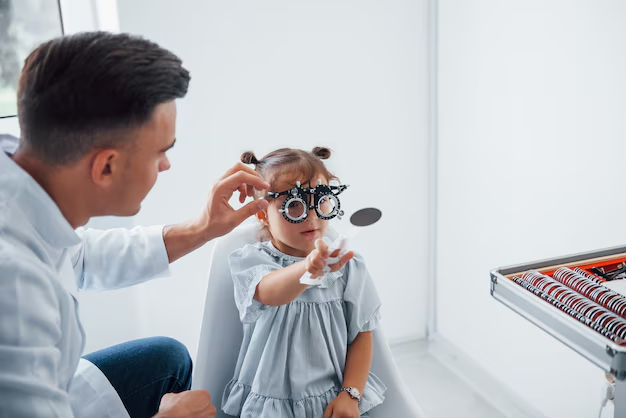
Children's eye checkups are essential for monitoring their visual development, detecting any eye problems early, and ensuring optimal eye health. Here's what typically happens during a children's eye checkup:
- Medical History: The eye care professional will start by asking questions about the child's medical history, including any family history of eye conditions, previous eye injuries or surgeries, and any existing medical conditions that could affect eye health.
- Visual Acuity Testing: Visual acuity testing measures how well a child can see at various distances. This is typically done using an eye chart with letters, shapes, or pictures appropriate for the child's age and development.
- Refraction: Refraction testing determines the child's need for glasses or contact lenses by measuring their refractive error (nearsightedness, farsightedness, astigmatism). This can be done using a phoropter or an autorefractor.
- Eye Alignment and Movement: The eye care professional will assess the child's eye alignment and movement to check for strabismus (misalignment of the eyes) or amblyopia (lazy eye). Tests may include the cover-uncover test, alternate cover test, and assessing fixation and follow-up.
- Binocular Vision Assessment: Binocular vision testing evaluates how well the child's eyes work together as a team. This includes tests for depth perception, convergence (ability to focus on near objects), and stereopsis (3D vision).
- Eye Health Examination: The eye care professional will examine the health of the child's eyes, including the eyelids, conjunctiva, cornea, iris, lens, and retina. This may involve the use of a slit lamp microscope and ophthalmoscope to view the structures of the eye.
- Dilation: In some cases, the eye care professional may dilate the child's pupils using eye drops to get a better view of the back of the eye (retina). Dilated eye exams are particularly important for detecting conditions such as retinopathy of prematurity (ROP) or congenital cataracts.
- Screening for Other Conditions: Depending on the child's age, risk factors, and presenting symptoms, additional screening tests may be performed for conditions such as amblyopia, color vision deficiency, or pediatric glaucoma.
- Discussion and Recommendations: After the examination, the eye care professional will discuss their findings with the child and their parents or guardians. They will provide recommendations for any necessary treatment or further evaluation, such as glasses, vision therapy, or referral to a specialist if needed.
Regular eye checkups are crucial for children, as many vision problems can be successfully treated if detected early. It's recommended that children have their first comprehensive eye exam at around 6 months of age, followed by additional exams at age 3 and before starting school, with regular exams thereafter as recommended by their eye care professional.
Copyright @ NARAIN EYE CARE